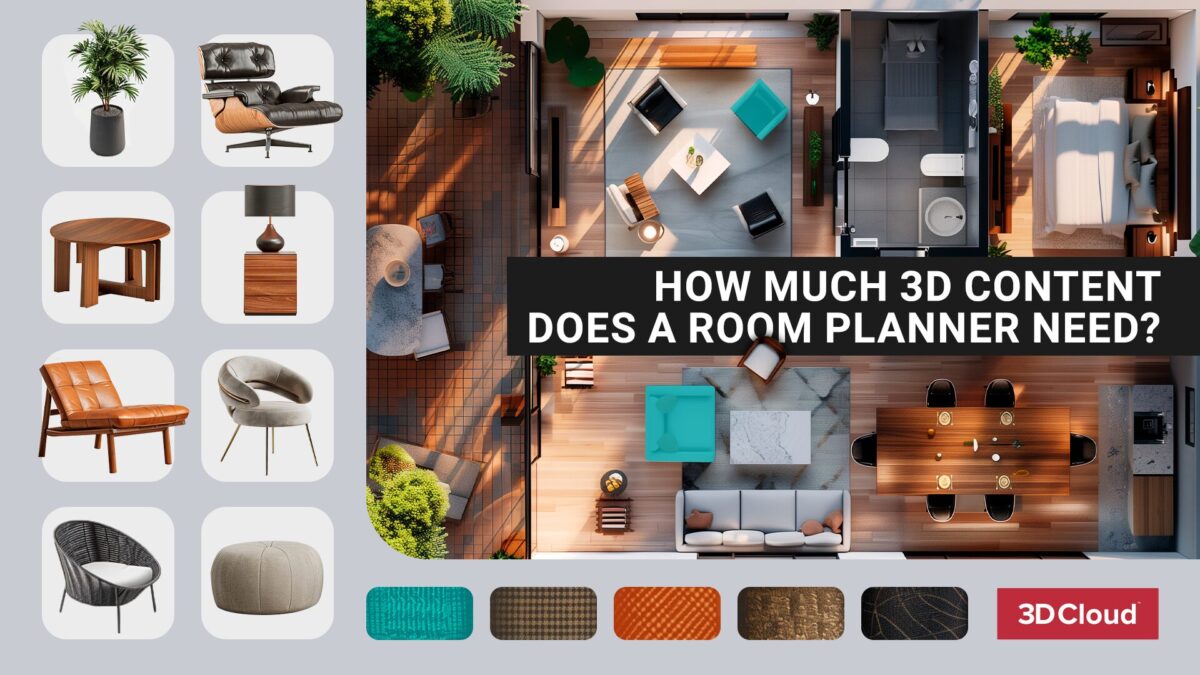
The 3D Cloud 3D Room Planner with Design from Photo is a great way to get customers engaged with Room Commerce® – buying whole rooms of furniture either online or in-store with the help of a sales associate. Once a retailer has decided to improve their customer experience with 3D Cloud’s 3D Room Planner, the next step is deciding how to merchandise the app.
Each individual product geometry along with its associated textures and materials must be modeled in 3D. The models are then assigned product data, managed, and hosted. It’s challenging to get 100 percent of a product catalog 3D modeled on a tight timeline, so you want to make smart choices that get your most popular products into the app without delaying the product launch. No wonder that one of the first questions we are asked about the 3D Room Planner is “How much 3D content does my room planner need at launch?”
It’s a great question! Getting the content right is one of the most important aspects of a high-performing Room Commerce application. Because content requires planning and can be expensive, it is important to take a thoughtful and strategic approach.
How do we know so much about what the right content mix looks like? We work with some of the largest top 25 furniture retailers and over the past 12 months, tens of thousands of 3D Room Planner projects have been created in over half a million sessions across all of our partners, leveraging thousands of individual SKUs. All of these recommendations are backed up by data and many years of experience.
This article includes answers to frequently asked questions about 3D Room Planner content merchandising, including:
- What’s the minimum number of 3D products required at launch?
- How many products should our 3D Room Planner have at maturity?
- What content is most popular in 3D Room Planner apps?
- What is the ideal breakdown of content by category?
- Do we order content just once, or is it a continuous process?
What’s the minimum number of 3D products required for a 3D Room Planner to launch successfully?
We work with clients that have enormous product catalogs – and some with smaller catalogs. The rule of thumb is to ensure that at least 20 percent or a minimum of 1,500 products are available to customers for designing within the app.
How many products should our 3D Room Planner have at maturity?
In a perfect world, a mature 3D Room Planner will have a minimum of 5,000 products or 50 percent of total SKUs carried by the retailer, whichever is higher. The more content, the more creative customers can get and the more likely they are to buy bigger baskets. Shoppers love to finish out their spaces with staging and accent content such as planters, mirrors, rugs, mirrors — and even pets.
What content is most popular in 3D Room Planner apps?
The most popular content is consistently large-scale, expensive products such as sectionals, sofas, bedroom sets, and dining sets. Even so, it’s important to have a wide variety of content that can be used to create complete room designs such as a fully furnished bedroom or a conversation seating arrangement. Accents like rugs and mirrors offer great upsell opportunities and can provide polish that builds customer confidence.
What is the ideal breakdown of content by category?
Think about merchandising the app in the same way that you would merchandise a store. You wouldn’t offer a single sofa or bedroom set for sale in-store, and you wouldn’t leave rugs, storage, and mirrors to the imagination. A successful Room Commerce strategy requires a healthy mix of products and variety within popular categories. Based on an analysis of 3D content inventory across clients, the ideal content mix looks something like this:
- Living Room – 35%
- Bedroom – 20%
- Dining Room – 14%
- Accessories – 18%
- Outdoor – 8%
- Home Office – 5%

Do we order 3D content once, or continuously?
We recommend starting off with a minimum of 1,500 products or 20 percent of the total product catalog with the goal of getting up to 50 percent of the total catalog within the first 2 – 3 years. Content decays at a rate of 3 – 5 percent per month and aged inventory needs to be retired and replaced with fresh products that shoppers can buy, so it is important to take both decay and content library growth into consideration in the content planning process. Placing regular content orders ensures that your product library is robust, current, and buyable.
Getting started with the 3D Cloud 3D Room Planner with Design from Photo is fast and easy. Once you figure out what content you want to feature, we take care of the rest.









